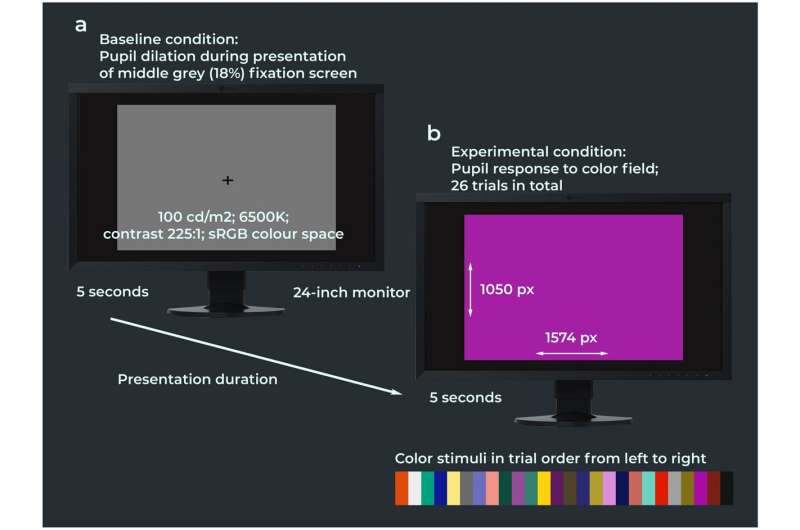This article has been reviewed according to Science X's editorial process and policies. Editors have highlighted the following attributes while ensuring the content's credibility:
fact-checked
peer-reviewed publication
trusted source
proofread
How the brains of healthy older adults perceive color

There is a difference between how the brains of healthy older adults perceive color compared to younger adults, finds a new study led by UCL researchers.
The research, published in Scientific Reports, compared how the pupils of younger and older people reacted to different aspects of color in the environment.
The team recruited 17 healthy young adults with an average age of 27.7, and 20 healthy older adults with an average age of 64.4.
Participants were placed in a blackout room and shown 26 different colors for five seconds each, while the researchers measured the diameter of their pupils.
Pupils constrict in response to increases in color lightness and chroma (colorfulness).
The colors shown included dark, muted, saturated and light shades of magenta, blue, green, yellow and red, alongside two shades of orange and four greyscale colors.
Using a highly sensitive eye tracking camera, which recorded the pupil diameter at 1,000 times per second, the team found that the pupils of healthy older people constricted less in response to color chroma compared with young adults. This was particularly marked for green and magenta hues.
However, both younger and older adults had similar responses to the "lightness" of a color shade.
The study is the first to use pupillometry to show that as we grow older, our brains become less sensitive to the intensity of colors in the world around us.
The findings of the study also complement previous behavioral research that showed that older adults perceive surface colors to be less colorful than young adults.
Lead author, Dr. Janneke van Leeuwen (UCL Queen Square Institute of Neurology), explained, "This work brings into question the long-held belief among scientists that color perception remains relatively constant across the lifespan, and suggests instead that colors slowly fade as we age. Our findings might also help explain why our color preferences may alter as we age—and why at least some older people may prefer to dress in bold colors."
The researchers believe that as we get older there is a decline in the body's sensitivity to the saturation levels of colors within the primary visual cortex—the part of the brain that receives, integrates, and processes visual information relayed from the retinas.
Previous research also showed this to be a feature of a rare form of dementia called posterior cortical atrophy (PCA), where noticeable difficulties and abnormalities in color perception could be due to a significant decline in the brain's sensitivity to certain color tones (specifically green and magenta) in the primary visual cortex and its connected networks.
Co-corresponding author, Professor Jason Warren (UCL Queen Square Institute of Neurology), noted, "Our findings could have wide implications for how we adapt fashion, décor and other color 'spaces' for older people, and potentially even for our understanding of diseases of the aging brain, such as dementia.
"People with dementia can show changes in color preferences and other symptoms relating to the visual brain—to interpret these correctly, we first need to gauge the effects of healthy aging on color perception. Further research is therefore needed to delineate the functional neuroanatomy of our findings, as higher cortical areas might also be involved."
More information: Janneke E. P. van Leeuwen et al, Pupil responses to colorfulness are selectively reduced in healthy older adults, Scientific Reports (2023). DOI: 10.1038/s41598-023-48513-7




















